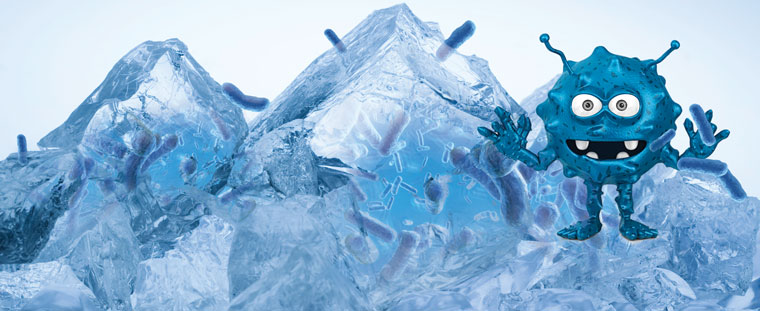The bacterium that came in from the cold

Some animals live for 200 years or more, and there are trees which live much longer still.1,2 But here’s a story about an organism which, some scientists say, trumps them all. There have been several recent claims that scientists have found living bacteria many millions of years old,3 and now another similar claim has been made by researchers from Newcastle University, UK.
While studying seafloor sediments off the Norwegian archipelago of Svalbard, researchers were surprised to find dormant spores of a thermophilic (heat-loving) bacterium. These germinate when temperatures reach a very warm 50°C, similar to microbes which thrive deep in the oceanic crust, and in sub-surface oil reservoirs. Given the frigid conditions at Svalbard, the scientists could not account for the presence of a bacterium that relies on a much warmer environment to complete its life-cycle.4
Dr Casey Hubert, one of the researchers, proposed that the bacteria leak out of the ocean crust in rising hot fluids, ending up in the icy arctic seawater where they become dormant due to the cold. So far, so good, as hydrothermal fluids have been observed emerging from the seafloor in other locations. But Hubert’s theory then goes that, in order for the bacteria to complete their life-cycle, they must wait to become deeply buried in very large quantities of sediment again, until conditions become warm enough for them to germinate. And going by observable rates of sea floor sedimentation occurring today, Hubert claims it would take 100 million years to deposit such deep quantities of sediment. So he is using this sedimentation rate to justify the claim that the bacterium has a 100 million-year life-cycle.
According to other experts, the DNA of bacteria would be destroyed within 100 thousand years due to the effects of molecular motion and background radiation, consistent with the second law of thermodynamics,5 so Hubert cannot be right. In any case, his claim is observationally unverifiable, as no known test can confirm that a dormant spore can live anything like as long as he claims.
It is drawing a very long bow indeed for the researchers who found the bacterium off Svalbard. In fact, they don’t yet know how, when or even if the dormant spores will germinate. They used the secular geological principle of uniformitarianism, the idea that present conditions are the key to the past, when they accepted that today’s (observable) sedimentation rate applied for the alleged (and unobserved) previous 100 million years.
But we know from the dependable eyewitness record of the Bible, and from much supporting evidence, that the whole world suffered a massive flood some 4,500 years ago, during which sedimentation rates would have been vastly greater than what is observed today. The scientists are speculating, in the dark and without evidence, when they talk of a bacterium that takes an unobserved, and very long, 100 million years to come in from the cold.
References and notes
- For instance, there are reports of captive tortoises and fish living for over 200 years, and some trees can live for thousands of years. Return to text.
- Interestingly, while the exact age is sometimes disputed, maximum ages for still-living trees quoted by scientists are often in close accord with the biblical date for Noah’s flood, about 4,500 years ago. See Bates, G., Patriarchs of the forest, Creation 25(1):10–13, 2002; creation.com/patriarchs-of-the-forest. Return to text.
- Vreeland, R.H., Rosenzweig, W.D., Powers, D.W., Isolation of a 250 million-year-old halotolerant bacterium from a primary salt crystal, Nature 407(6806):897–900, 2000; Salty Saga, Creation 23(4):15, 2001; creation.com/salty-saga. Return to text.
- Dartnell, L., Bug in the Arctic is the ultimate sleeping beauty, New Scientist, www.newscientist.com, 25 September 2010. Return to text.
- In fact, laboratory studies indicate that “no DNA would remain intact much beyond 10,000 years.” Sykes, B., The past comes alive, Nature 352(6334):381–382, 1991; see also Catchpoole, D., Sleeping Beauty bacteria, Creation 28(1):23, 2005; creation.com/sleeping-beauty-bacteria; and the sequel creation.com/more-sleeping-beauty-bacteria, 2007. Return to text.


Readers’ comments
Comments are automatically closed 14 days after publication.